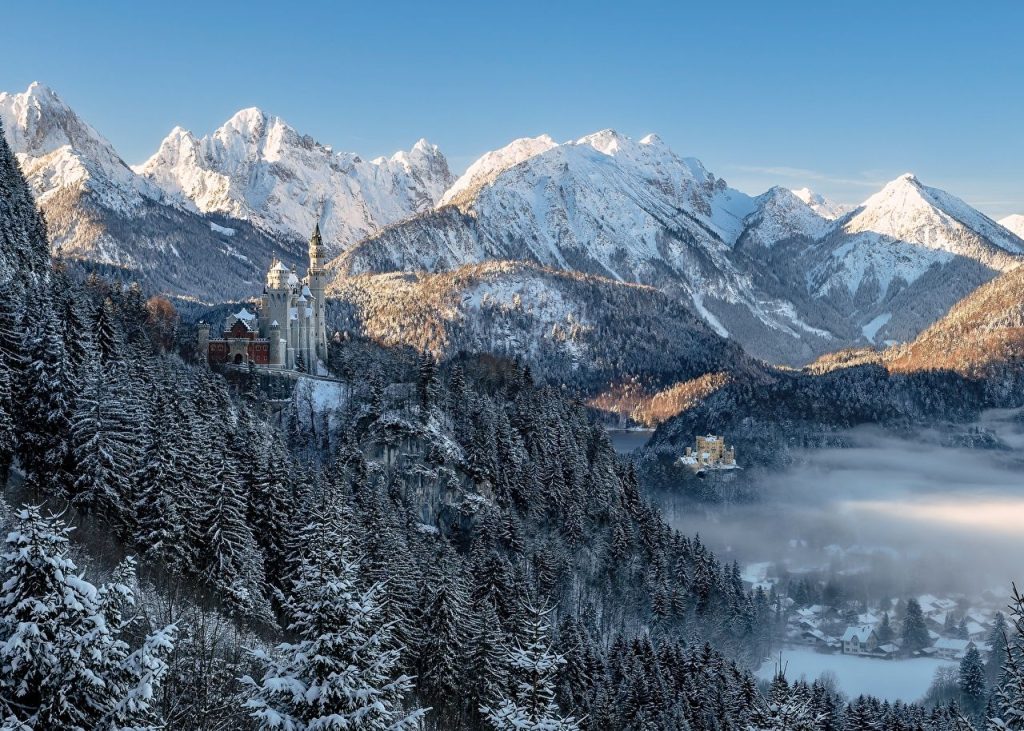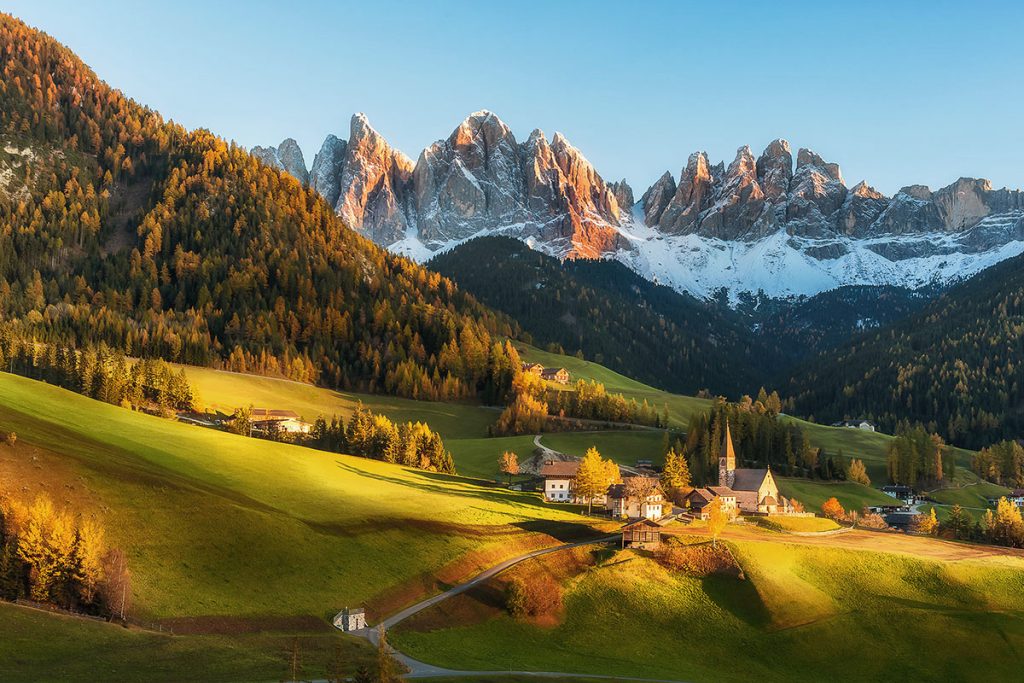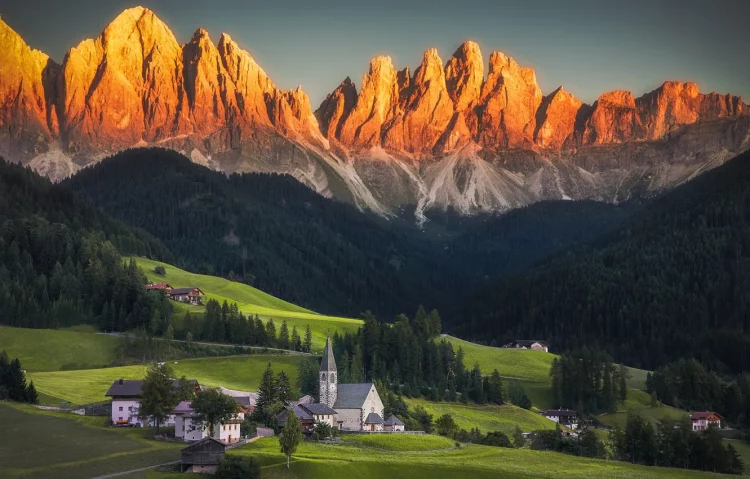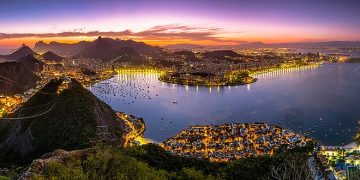In south-central Europe, there is a magnificent mountain range, which spans many countries and is not only a collection of natural beauty, but also a meeting point of history, culture and economy. These mountains are known as the Alps. This paper will deeply explore the geographical location, topography and climate characteristics of the Alps, elaborate its history, culture, religious beliefs and ethnic customs, analyze its impact on the local economy, society and ecology, as well as its status and role in international affairs, and combine personal experience and feelings to carry out in-depth perception and reflection on this magical mountain.
I. Geographical overview of the Alps
Geographical position
The Alps are located in south-central Europe, extending in an arc from the subtropical Mediterranean coast near Nice, France, north to Lake Geneva, and northeast to Vienna on the Danube. The mountain range covers northern Italy, southeastern France, Switzerland, Liechtenstein, Austria, southern Germany and Slovenia, with a length of about 1,200 km, a width of 130 to 260 km, an average altitude of about 3,000 meters, and a total area of about 220,000 square kilometers. In this vast mountain region, 82 peaks are more than 4,000 meters above sea level, and the highest peak, Mont Blanc, stands tall at 4,810 meters, standing on the border of France, Italy and Switzerland.
landform
The geomorphic features of the Alps are extremely rich and diverse, which can be summarized as majestic mountains, extensive development of glacial landforms, passes between the mountains, and terrain inconsistency between the eastern and western parts. In terms of elevation, the Alpine landscape can be divided into three parts: piedmont floodplains and lowlands (below 500 m above sea level), hilly areas (between 500 and 1000 m above sea level), and mountainous areas (above 1000 m above sea level). The mountainous part is mainly composed of crystalline rock alpine mountain and limestone alpine mountain, and the height difference between the valley floor and the nearby peak can be as much as 3,000 meters, showing the extremely spectacular vertical landscape.
Glaciation has had a profound effect on the topography of the Alps. This is the center of the largest mountain glacier in Europe, covered with ice sheets up to 1 km thick, and various types of glacial landforms, especially glacial erosion landforms, are typical. There are still more than 1,200 glaciers in modern times, with a total area of about 4,000 square kilometers, of which the Aletsch Glacier in southwest Switzerland is the most spectacular, about 22.5 kilometers long and about 130 square kilometers in area. The erosion and sedimentation of glaciers not only form many magnificent natural landscapes, but also provide fertile land and convenient transportation conditions for human activities.
Climatic characteristics
The Alps lie between temperate and subtropical latitudes, forming the dividing line between the temperate continental humid climate of Central Europe and the subtropical summer dry climate of southern Europe. Its climate features are complex and changeable, and the temperature decreases significantly with the increase of altitude, with an average temperature drop of about 1℃ for every 100 meters of increase. In summer, the southern slope is sunny and facing the Mediterranean wind, and the temperature lapse rate is small, while in winter, due to the inversion phenomenon in the deep valley, the low temperature is low and the high temperature is increased. Precipitation increases with elevation, but decreases gradually after a certain height. The western Alps have more precipitation than the eastern Alps due to their high height and westerly wind position. This unique climatic condition breeds a rich biodiversity, from forests and grasslands in the lowlands to rocks and mosses in the mountains, where vegetation is stratified and ecosystems are complex and diverse.

Second, the history, culture and national customs of the Alps
History and culture
The Alps are not only famous for their natural scenery, but also carry a profound historical and cultural heritage. Since ancient times, this mountain range has been an important stage in European history. During the Roman Empire, the Alps, as the front line of the Germanic barbarians of the North and the Roman Empire, witnessed numerous alternations of war and peace. With the evolution of history, the Alps gradually became the meeting point of cultural, religious and ethnic integration of European countries. Switzerland, Austria, Italy and other countries in the course of history, have left a deep imprint of the Alps.
The Alps were also one of the birthplaces of the Romantic movement in Europe. Many artists and writers have been attracted by the natural beauty here, leaving countless popular works. The works of cultural giants such as Kafka, Tolstoy, and Beethoven are full of depictions and praise of the Alps, making them occupy an important position in European culture. These works not only convey the natural beauty of the Alps, but also contain profound reflections on life, freedom and ideals.
Religious beliefs and ethnic customs
The Alpine region is inhabited by a number of ethnic groups, each retaining their unique religious beliefs and ethnic customs. In Switzerland, the Alps are not only a symbol of the country, but also the sustenance of the national spirit. The local people love nature and tradition, and their way of life, festivals and folk art are deeply marked by the Alps. For example, Swiss Alpine horns, folk dances and handicrafts are all vivid manifestations of Alpine culture.
The Alpine region also retains a rich religious tradition. A variety of religions such as Catholicism and Protestantism coexist harmoniously here, forming a unique religious and cultural atmosphere. Many ancient churches, monasteries and places of pilgrimage are located in the arms of the Alps, attracting believers from all over the world to worship and pray.
The impact of the Alps on the local economy, society and ecology
Economic impact
The impact of the Alps on the local economy is profound and widespread. As one of the largest mountain ranges in Europe, the Alps not only provide rich natural resources for the local population, but also an important pillar of tourism, agriculture and livestock. With four distinct seasons and pleasant scenery, it attracts tourists from all over the world to come for sightseeing, skiing, hiking and hiking. Switzerland, Austria and other countries have highly developed tourism, largely thanks to the unique charm of the Alps.
The Alps are also home to many internationally renowned brands and companies. Such as Swiss watches, French wine, etc., these brands and products represent world-class quality and craftsmanship, and bring considerable benefits to the local economy. At the same time, the Alps are rich in hydropower resources, which provides a strong guarantee for electricity production and further promotes the development of the local economy.
Social influence
The impact of the Alps on local society cannot be ignored either. The people here have lived in the mountains for generations, forming a unique community structure and way of life. They love nature, respect tradition, and value the harmonious coexistence of family and community. The Alps are not only their living place, but also their spiritual home. Here one can find inner peace and tranquility and feel the gift and power of nature.
The Alps also promote international exchange and cooperation. As a mountain range across many countries, the Alps have become a bridge and a bond of friendship between people of all countries. Countries have carried out extensive cooperation and exchanges in the fields of environmental protection, tourism development, cultural exchanges and other fields, and jointly promoted the sustainable development of the Alps region.
Ecological impact
The ecology of the Alps is extremely valuable and fragile. It is rich in biodiversity, including a large number of plant, animal and insect species. Vegetation ranges from lowland forests and grasslands to alpine rocks and mosses, forming a complex and diverse ecosystem. However, with the continuous intensification of human activities, the ecological environment of the Alps is facing unprecedented challenges. Climate change, environmental pollution, overdevelopment and other problems are becoming increasingly serious, posing a serious threat to the local biodiversity and ecological balance.
It is particularly important to protect the ecological environment of the Alps. Governments and international organizations have taken measures to strengthen ecological protection and promote the implementation of sustainable development strategies. Efforts are made to maintain the ecological balance and biodiversity of the Alps through measures such as strengthening environmental monitoring, reducing pollution emissions and restoring damaged ecology.
The status and role of the Alps in international affairs
As one of the largest mountain ranges in Europe, the Alps also play an important role in international affairs. It is not only an important geographical and climatic demarcation line of Europe, but also a juncture of the territory of many countries, which has an important influence on the political pattern and security situation of Europe. Cooperation and exchanges between countries in the Alpine region will not only enhance mutual understanding and trust, but also contribute to regional peace and stability.

The Alps are also an important venue for international tourism and sports competitions. Every year attracts a large number of tourists to visit and participate in various sports competitions. These activities not only promote the development of the local economy and the prosperity of tourism, but also increase the visibility and influence of the Alps in the international community. At the same time, cooperation and exchanges between countries in tourism development and sports competition will also help promote the development of global tourism and sports.
- Personal experience and perception
As a former traveler to the Alps, I was fascinated by the grandeur and mystery of this mountain range. Standing on the summit of Mont Blanc overlooking the rolling mountains and clouds, I felt like I was in a dreamlike world. At that moment, I felt the power of nature and the insignificance of human beings, as well as the meaning and value of life.
The Alps not only let me appreciate the beauty of nature, but also let me feel the harmonious coexistence between man and nature. Here I saw the local residents’ reverence and love for nature, as well as their way of living in harmony with nature. These experiences have made me deeply realize the importance of protecting the ecological environment and the necessity of sustainable development.
At the same time, the Alps also gave me spiritual healing and enlightenment. In this pure and quiet land I found inner peace and tranquility, as if all my troubles and worries were gone with the wind. I felt the simplicity and beauty of life and the fragility and preciousness of life. These insights make me cherish everything in front of me more and strengthen the belief in pursuing dreams and ideals.
Alps is a collection of nature and humanity in one of the magic mountains, it not only has magnificent natural scenery and rich history and culture but also carries profound national emotions and spiritual sustenance. This mountain range has had a profound impact on the local economy, society, ecology and international affairs. As the common precious wealth of mankind, we should cherish and protect this magical land so that it will always be full of vitality and vitality. In the coming days, may we all be able to explore the true meaning of life with a calm and transparent heart and feel the endless charm and inspiration brought to us by the Alps.





















